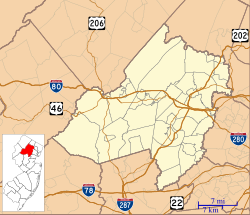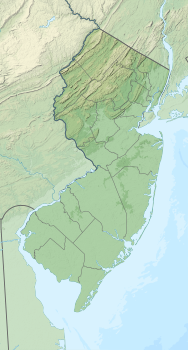Budd Lake, New Jersey
 From Wikipedia - Reading time: 13 min
From Wikipedia - Reading time: 13 min
Budd Lake, New Jersey | |
|---|---|
 | |
 Location in Morris County and the state of New Jersey. | |
Location in Morris County Location in New Jersey | |
| Coordinates: 40°52′25″N 74°44′13″W / 40.873494°N 74.736828°W | |
| Country | |
| State | |
| County | Morris |
| Township | Mount Olive |
| Named for | John Budd |
| Area | |
• Total | 6.42 sq mi (16.64 km2) |
| • Land | 5.44 sq mi (14.10 km2) |
| • Water | 0.98 sq mi (2.54 km2) 15.27% |
| Elevation | 928 ft (283 m) |
| Population | |
• Total | 9,784 |
| • Density | 1,797.2/sq mi (693.9/km2) |
| Time zone | UTC−05:00 (Eastern (EST)) |
| • Summer (DST) | UTC−04:00 (Eastern (EDT)) |
| ZIP Code | 07828[4] |
| Area code(s) | 862/973 |
| FIPS code | 3408620[5][6][7] |
| GNIS feature ID | 2389258[5][8] |

Budd Lake is an unincorporated community and census-designated place (CDP) located within Mount Olive Township, in Morris County, in the U.S. state of New Jersey.[9][10][11] As of the 2020 United States census, the CDP's population was 9,784,[3] its highest decennial census count ever and an increase of 816 (+9.1%) from the 8,968 enumerated at the 2010 census,[12] which in turn reflected an increase of 868 (+10.7%) from the 8,100 counted in the 2000 census.[13] Budd Lake was named for John Budd.[14] Prior to that, it was called Hattacawanna Lake.[15]
Geography
[edit]Budd Lake is in western Morris County, in central Mount Olive Township. U.S. Route 46 passes through the community, leading northeast 3 miles (5 km) to Netcong and southwest 5 miles (8 km) to Hackettstown. Interstate 80 passes just north of the community. New York City is 46 miles (74 km) to the east via I-80, and the Delaware Water Gap is 25 miles (40 km) to the west.
According to the U.S. Census Bureau, the Budd Lake CDP has a total area of 6.424 square miles (16.64 km2), including 5.444 square miles (14.10 km2) of land and 0.980 square miles (2.54 km2) of water (15.26%).[1]
Budd Lake
[edit]Budd Lake, which the community is named after, is the source of the South Branch Raritan River. A glacial lake at an elevation of 933 feet (284 m), Budd Lake has a surface area of 374 acres (1.51 km2).[16] It is 7 to 12 feet (2.1 to 3.7 m) deep and can have large algal blooms. The adjacent bog, created by thousands of years of decaying plant material, supports wetland plants such as black spruce and tamarack, which grow on the floating mass.[16] The lake is recharged through groundwater seepage through a series of wetlands, and serves as the headwaters of the Raritan River's South Branch.[17] It is closely bordered by U.S. Route 46 to the south and Sand Shore Road to the east.[18]
Budd Lake was named for John Budd, who acquired 1,300 acres (530 ha) of land in the area in 1714.[19] Prior to that, it was called Hattacawanna Lake.[20]
Demographics
[edit]| Census | Pop. | Note | %± |
|---|---|---|---|
| 1960 | 1,520 | — | |
| 1970 | 3,168 | 108.4% | |
| 1980 | 6,523 | 105.9% | |
| 1990 | 7,272 | 11.5% | |
| 2000 | 8,100 | 11.4% | |
| 2010 | 8,968 | 10.7% | |
| 2020 | 9,784 | 9.1% | |
| Population sources: 1960-1980[21] 1990-2010[11] 2000[13] 2010[12] 2020[3] | |||
2010 census
[edit]The 2010 United States census counted 8,968 people, 3,232 households, and 2,385 families in the CDP. The population density was 1,647.5 people per square mile (636.1 people/km2). There were 3,423 housing units at an average density of 628.8 units per square mile (242.8 units/km2). The racial makeup was 80.88% (7,253) White, 6.39% (573) Black or African American, 0.16% (14) Native American, 7.71% (691) Asian, 0.09% (8) Pacific Islander, 2.39% (214) from other races, and 2.40% (215) from two or more races. Hispanic or Latino of any race were 13.08% (1,173) of the population.[12]
Of the 3,232 households, 39.6% had children under the age of 18; 59.0% were married couples living together; 10.2% had a female householder with no husband present and 26.2% were non-families. Of all households, 20.9% were made up of individuals and 4.9% had someone living alone who was 65 years of age or older. The average household size was 2.77 and the average family size was 3.24.[12]
26.4% of the population were under the age of 18, 8.1% from 18 to 24, 29.1% from 25 to 44, 28.7% from 45 to 64, and 7.7% who were 65 years of age or older. The median age was 37.6 years. For every 100 females, the population had 100.6 males. For every 100 females ages 18 and older there were 95.0 males.[12]

2000 census
[edit]As of the 2000 United States Census[6] there were 8,100 people, 2,851 households, and 2,169 families living in the CDP. The population density was 534.6 people/km2 (1,385 people/sq mi). There were 2,994 housing units at an average density of 197.6 units/km2 (512 units/sq mi). The racial makeup of the CDP was 87.11% White, 3.54% African American, 0.07% Native American, 5.80% Asian, 1.47% from other races, and 2.00% from two or more races. Hispanic or Latino of any race were 6.62% of the population.[13]
There were 2,851 households, out of which 43.7% had children under the age of 18 living with them, 62.7% were married couples living together, 9.4% had a female householder with no husband present, and 23.9% were non-families. 18.4% of all households were made up of individuals, and 3.9% had someone living alone who was 65 years of age or older. The average household size was 2.83 and the average family size was 3.25.[13]
In the CDP the population was spread out, with 28.7% under the age of 18, 6.9% from 18 to 24, 37.5% from 25 to 44, 21.2% from 45 to 64, and 5.8% who were 65 years of age or older. The median age was 34 years. For every 100 females, there were 99.0 males. For every 100 females age 18 and over, there were 96.5 males.[13]
The median income for a household in the CDP was $62,540, and the median income for a family was $70,585. Males had a median income of $44,631 versus $35,316 for females. The per capita income for the CDP was $24,581. About 1.9% of families and 3.3% of the population were below the poverty line, including 2.4% of those under age 18 and 3.9% of those age 65 or over.[13]
Transportation
[edit]NJ Transit offers local bus service on the MCM5 route.[22][23]
Notable people
[edit]People who were born in, residents of, or otherwise closely associated with Budd Lake include:
- Tim Jacobus (born 1959), artist best known for illustrating the covers for nearly one hundred books in R. L. Stine's Goosebumps series[24]
- PES (born 1973 as Adam Pesapane), Oscar and Emmy-nominated director and stop-motion animator, whose short film Fresh Guacamole was nominated for the Academy Award for Best Animated Short Film in 2013[25]
- Ryan Peterson (born 1995), professional footballer who plays for the Charlotte Independence in USL League One[26]
- Jen Ponton (born 1984), actress, screenwriter and producer, best known for portraying Rubi in the AMC series Dietland[27]
See also
[edit]References
[edit]- ^ a b "2024 U.S. Gazetteer Files: New Jersey". United States Census Bureau. Retrieved October 2, 2024.
- ^ U.S. Geological Survey Geographic Names Information System: Budd Lake Census Designated Place, Geographic Names Information System. Accessed July 11, 2012.
- ^ a b c QuickFacts Budd Lake CDP, New Jersey, United States Census Bureau. Accessed June 18, 2023.
- ^ Look Up a ZIP Code for Keyport, NJ, United States Postal Service. Accessed July 11, 2012.
- ^ a b Gazetteer of New Jersey Places, United States Census Bureau. Accessed July 21, 2016.
- ^ a b U.S. Census website, United States Census Bureau. Accessed September 4, 2014.
- ^ Geographic Codes Lookup for New Jersey, Missouri Census Data Center. Accessed June 9, 2023.
- ^ US Board on Geographic Names, United States Geological Survey. Accessed September 4, 2014.
- ^ GCT-PH1 - Population, Housing Units, Area, and Density: 2010 - County – County Subdivision and Place from the 2010 Census Summary File 1 for Morris County, New Jersey Archived 2020-02-12 at archive.today, United States Census Bureau. Accessed December 23, 2012.
- ^ 2006-2010 American Community Survey Geography for New Jersey, United States Census Bureau. Accessed December 23, 2012.
- ^ a b New Jersey: 2010 - Population and Housing Unit Counts - 2010 Census of Population and Housing (CPH-2-32), United States Census Bureau, August 2012. Accessed December 23, 2012.
- ^ a b c d e DP-1 - Profile of General Population and Housing Characteristics: 2010 Demographic Profile Data for Budd Lake CDP, New Jersey Archived February 12, 2020, at archive.today, United States Census Bureau. Accessed July 11, 2012.
- ^ a b c d e f DP-1 - Profile of General Demographic Characteristics: 2000 from the Census 2000 Summary File 1 (SF 1) 100-Percent Data for Budd Lake CDP, New Jersey Archived 2020-02-12 at archive.today, United States Census Bureau. Accessed December 23, 2012.
- ^ The History of Mt. Olive Archived 2006-04-30 at the Wayback Machine, accessed July 17, 2006
- ^ Manuscript Group 1187, Forest House Hotel, Hattacawanna Lake, NJ Archived 2007-03-11 at the Wayback Machine, accessed July 17, 2006
- ^ a b Budd Lake Bog Preserve, New Jersey Natural Lands Trust. Accessed August 17, 2011. "Curving along the northern end of New Jersey's largest naturally formed lake, Budd Lake Bog supports a wetland habitat rare in New Jersey.... Budd Lake is considered the headwater source for the South Branch of the Raritan River."
- ^ Voyce, Lisa. "Protecting Water Quality in the Highlands (and Elsewhere)" Archived 2006-08-08 at the Wayback Machine, ANJEC Report, Fall 2002 (PDF). Accessed August 17, 2011.
- ^ Google Maps Google. Accessed July 15, 2007.
- ^ The History of Mt. Olive Archived 2006-04-30 at the Wayback Machine, Mount Olive Township. Accessed August 17, 2011.
- ^ Manuscript Group 1187, Forest House Hotel, Hattacawanna Lake, NJ Archived 2007-03-11 at the Wayback Machine, New Jersey Historical Society. Accessed August 17, 2011.
- ^ Staff. 1980 Census of Population: Number of Inhabitants United States Summary, p. 1-141. United States Census Bureau, June 1983. Accessed January 12, 2012.
- ^ Morris County Bus / Rail Connections, NJ Transit, backed up by the Internet Archive as of May 22, 2009. Accessed December 23, 2012.
- ^ Morris County System map Archived June 19, 2015, at the Wayback Machine, NJ Transit. Accessed December 1, 2017.
- ^ Izzo, Michael. "'Goosebumps' cover artist living in Budd Lake". Daily Record. Daily Record. Retrieved September 25, 2015.
- ^ Hyman, Vicki. "Oscars 2013: Budd Lake's PES nominated for best animated short for appetizing Guacamole", NJ Advance Media for NJ.com, February 24, 2013. Accessed December 1, 2017. "Maybe you, like Adam Pesapane, have glanced at a mound of avocados in the supermarket and mistook them, for a moment, for a stockpile of grenades.... The Budd Lake native and Delbarton graduate is nominated for best animated short for Fresh Guacamole an infectiously entertaining stop-motion wonder that clocks in at one minute and 40 seconds, the shortest film ever nominated for an Oscar."
- ^ Ryan Peterson, Rutgers Scarlet Knights men's soccer. Accessed October 2, 2022. "Hometown: Budd Lake, N.J. High School: Mount Olive"
- ^ Izzo, Michael. "Budd Lake actress ready to break out in Free the Nipple", Courier News, November 17, 2014. Accessed September 4, 2019. "Mount Olive – Budd Lake's Jen Ponton has had a great few years, but she says the best is yet to come."
 KSF
KSF


